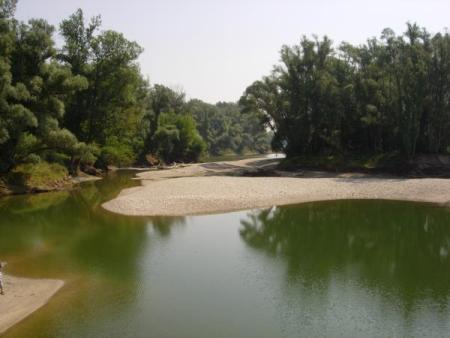
Area characterisation:
The Danube River Basin is the most international river basin in the world shared by more than 80 million people from 19 countries, all contracting parties of the International Commission for the Protection of the Danube River, which coordinates the conservation, improvement and rational use of the waters. The Danube connects with 27 large and over 300 small tributaries on its way from the Black Forest to the Black Sea with a catchment size of approximately 800,000km². The construction of hydropower dams represents one of the most severe pressures affecting river ecosystem integrity, as it involves the modification of riverine habitats, transformation of a river section into reservoir stretches, modifications of the hydrological regime, of water temperature, turbidity, sediment load, and the interruption of river continuity, causing large-scale effects for the river.
Objective:
Restoring river-floodplains to protect biodiversity: The Danube’s river biodiversity is threatened by changes to hydrology and geomorphology (so-called hydro-morphological alterations), such as disconnection of floodplains. Multiple human activities, including the construction of hydropower plants, expansion of agriculture, and large-scale river regulation measures to increase navigation and flood protection are resulting in an ongoing loss of habitat and biodiversity. Our aim: In this Case Study, we apply the AQUACROSS Assessment Framework to identify how management of river-floodplain systems along the Danube can be supported to jointly conserve and restore biodiversity and maximise the value that these ecosystems provide to human well-being.
Potential impacts/benefits:
The effects of multiple human activities on aquatic biodiversity and ecosystem services are evaluated for the Danube River. Thereby the AQUACROSS linkage framework is used to explore linkages between various human activities, pressures, ecosystem components, ecosystem functions and ecosystem services at basin scale. A policy analysis supports the identification of challenges in implementation of existing policies and the identification of appropriate Ecosystem Based Management responses. A quantitative approach specifically focuses on the navigable main stem of the Danube River, where the interactions of several human activities and pressures related to hydro-morphological alteration on biodiversity and ecosystem services are quantified.
Actions:
We prioritised sections of the river-floodplain systems for restoration and conservation, using a novel integrative modelling approach that considered multiple targets, including biodiversity protection as well as economic and human well-being. Unlike the current situation, where each country selects their own restoration sites based on national criteria, our method prioritizes sites along the length of the Danube independent from jurisdictional, administrative and political borders.
Transferability of result:
This project is a Case Study under the Horizon 2020 project AQUACROSS, which builds on work undertaken in the previous pillars to develop concepts, practices and tools for better implementation of Ecosystem Based Management. This includes identifying and understanding the linkages between aquatic ecosystems and human well-being and identifying innovative management responses for aquatic ecosystems.
Lessons learnt:
As part of the Horizon 2020 AQUACROSS project, this case study links social and ecological data and knowledge within one analysis to help decision-makers to pursue different objectives simultaneously, enabling “integrated planning”. Independently considering the whole Danube River as one ecosystem supports coordination and cooperation across countries and therefore has potential to foster consensus on a shared vision for the future.
Organisations:
Lead partner organisation: The Institute of Hydrobiology and Aquatic Ecosystem Management (IHG) is one of seven institutes within the Department of Water, Atmosphere and Environment at the University of Natural Resources & Life Sciences, Vienna (BOKU) is leading the research in the case study with close collaboration with Danube Delta National Institute for Research & Development (DDNI).
Cooperating partner: The International Commission for the Protection of the Danube River (ICPDR) is an International Organisation consisting of 14 cooperating states and the European Union. Since its establishment in 1998, the ICPDR has grown into one of the largest and most active international bodies of river basin management expertise in Europe. The ICPDR deals not only with the Danube itself, but also with the whole Danube River Basin, which includes its tributaries and ground water resources. It works to ensure the sustainable and equitable use of waters and freshwater resources in the Danube River Basin. The work of the ICPDR is based on the Danube River Protection Convention, the major legal instrument for cooperation and trans-boundary water management in the Danube River Basin.
Contacts:
For further information about the project: aquacross@ecologic.eu
Case study contact: Andrea Funk | University of Natural Resources & Life Sciences, Vienna (BOKU) | andrea.funk@boku.ac.at